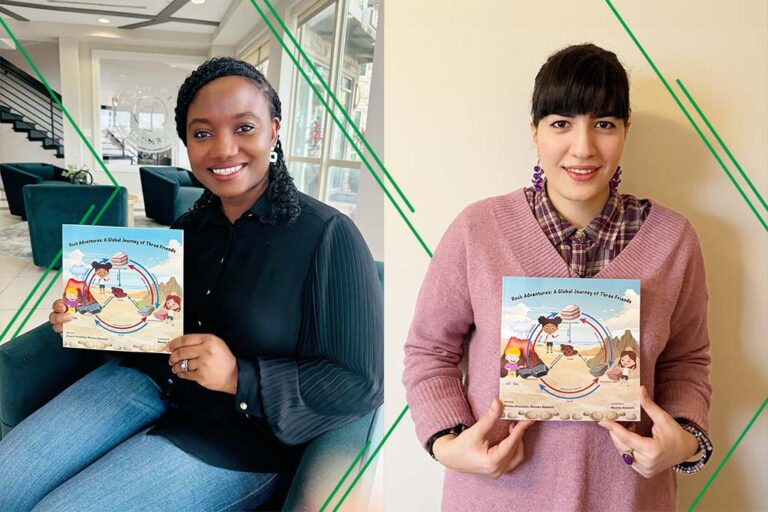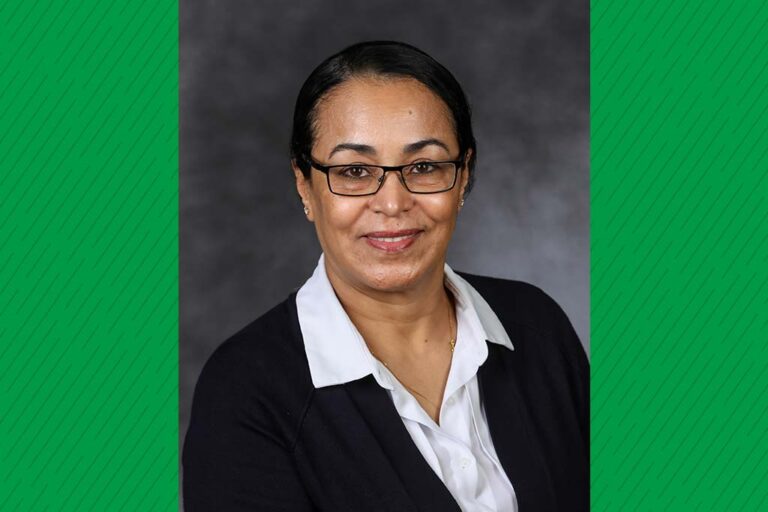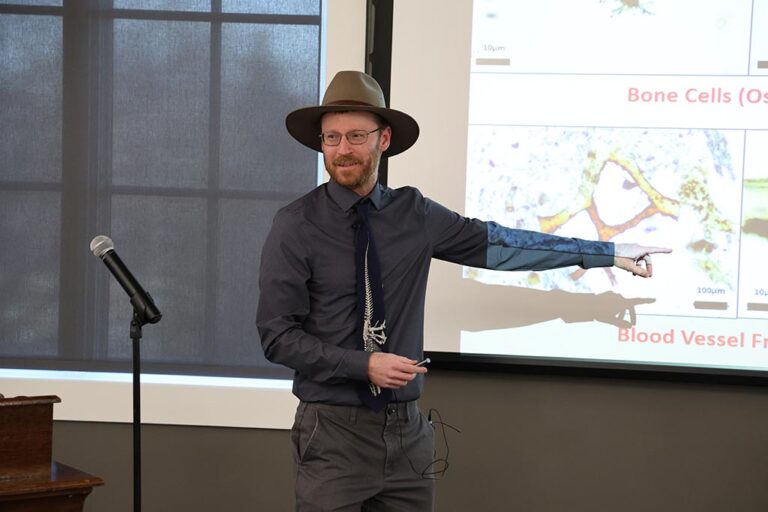Promising research for N.D. energy industry
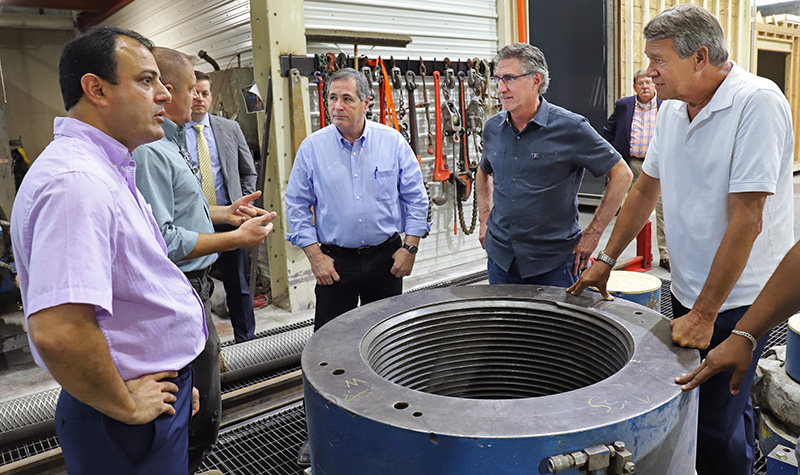 Members of the North Dakota Industrial Commission last week toured UND’s Drilling and Completions Lab and a pilot-scale plant to extract rare earth elements from coal. From left to right are Vamegh Rasouli, petroleum engineering chair; Harry Feilen, DRACOLA director; Brian Tande, CEM dean; Agriculture Commissioner Doug Goehring; Gov. Doug Burgum; and Attorney General Wayne Stenehjem. Photo by Patrick C. Miller/UND today.
Members of the North Dakota Industrial Commission last week toured UND’s Drilling and Completions Lab and a pilot-scale plant to extract rare earth elements from coal. From left to right are Vamegh Rasouli, petroleum engineering chair; Harry Feilen, DRACOLA director; Brian Tande, CEM dean; Agriculture Commissioner Doug Goehring; Gov. Doug Burgum; and Attorney General Wayne Stenehjem. Photo by Patrick C. Miller/UND today.
North Dakota Industrial Commission visits UND research facility it supports
Members of the North Dakota Industrial Commission last week got a close look at the UND College of Engineering & Mines research facilities they’re helping to fund, which focus on technologies directly benefiting North Dakota’s energy industry.
Gov. Doug Burgum, Attorney General Wayne Stenehjem and Agriculture Commissioner Doug Goehring – along with NDIC Executive Director Karlene Fine – visited the high-bay building that once housed the power plant for the city of Grand Forks, formerly operated by Minnkota Power Cooperative.
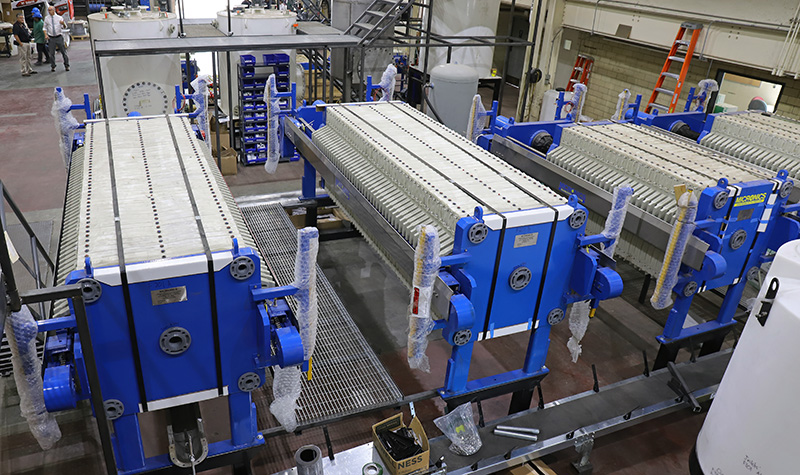
A pilot-scale plant to extract rare earth elements from North Dakota lignite coal could create a new industry for the state by replacing imported minerals for civil and military applications that are becoming more scarce and more expensive. Photo by Patrick C. Miller/UND Today.
The building is now occupied by the Drilling and Completion Lab (DRACOLA) run by CEM’s Department of Petroleum Engineering. Next to the full-scale oil and gas drilling rig, a pilot plant is being constructed to extract rare earth elements from North Dakota lignite coal under a UND Institute for Energy Studies project with the U.S. Department of Energy.

The Drilling and Completions Lab enables industry to test new drilling techniques while giving UND students real-world experience. From the left are Jake Fladeland; Mouna Keltoum Benabid, Ph.D. student, Algeria; Harry Feilen, Drilling & Completion Lab director; Vasanth Gokapai, Ph.D. student, Vijayawada, India; and Oscar Suarez. Photo by Patrick C. Miller/UND Today.
“We’re very appreciative of the state of North Dakota, especially for the Drilling and Completion Lab,” said Brian Tande, CEM dean. “They have funded just under $1 million toward this project over the last year or so.
“We’re getting the point where it will soon be operational,” he continued. “We can start bringing in industry partners to test some of their rock samples and their drilling techniques, enabling them to change parameters and really help optimize their operations in western North Dakota.”
Harry Feilen, DRACOLA director, described the lab as a place where industry customers and students can go to “get their hands on, get dirty and see what it’s all about.”
Pointing to the equipment, Feilen said, “That’s a real drill pipe with a real drill bit. We have real drill strings – the exact same things used by industry today. When the students are here, they’re doing this and actually getting their hands on stuff used in the real world.”
Vamegh Rasouli, Petroleum Engineering Department chair and Continental Resources Distinguished Professor, noted that UND’s petroleum engineering Ph.D. program is now in the top three in terms of student numbers in the United States. Burgum congratulated him on the accomplishment.
“With the support of NDIC, we now have over 80 Ph.D.s,” Rasouli said. “We have the most talented students from all around the world.”
Nolan Theaker, IES technical lead for rare earth and critical materials, briefed NDIC members on how the pilot-scale facility could lead to the commercialization of a technology to extract rare and valuable minerals from North Dakota lignite for both civilian and military applications ranging from batteries for electric vehicles to computers to missile guidance systems.
Stenehjem asked about the importance of the project in light of rare earth element supplies from China becoming less reliable and more expensive.
“With these elements, people have been looking for substitutes for 30 to 40 years,” Theaker answered. “No one has found a good one yet. I would be surprised if any substitutes ever pan out.”
But the pilot-scale plant being built with DOE and NDIC support could lead to North Dakota becoming a major supplier of the rare earth elements the world needs.
“At this scale, we’re processing just shy of a ton of lignite an hour, which is about 5 to 10 percent of the commercial facilities that we’re envisioning,” he said.
Theaker said IES has received letters of support for active participation in the project from every lignite mine and coal-fired power plant in the state. With this level of participation, he believes North Dakota could meet the needs of rare earth elements for the U.S. military by producing about 800 tons per year. If that’s successful, new commercial facilities could be built to help meet civilian demand. Burgum called the plan “a good vision.”
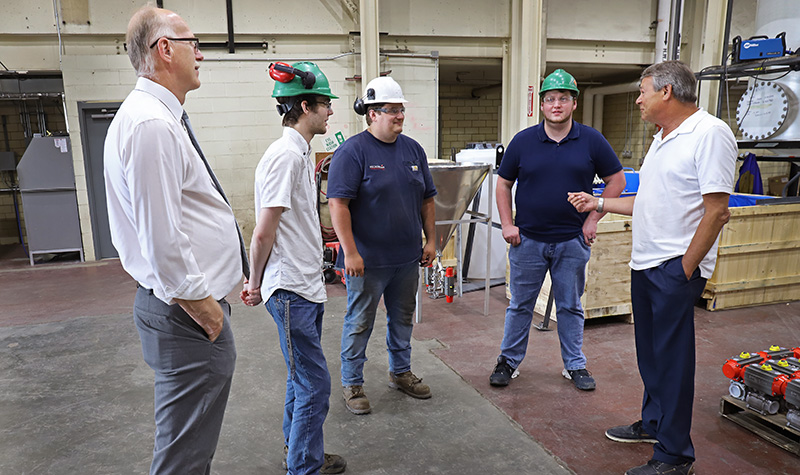
Attorney General Wayne Stenehjem (right) has questions for the rare earth elements research team. From the left are Mike Mann, IES executive director; Nicholas Dyrstad-Cincotta, IES research engineer, Eric Kolb, Microbeam Technologies Inc.; and Nolan Theaker, IES technical lead for rare earth and critical materials. Photo by Patrick C. Miller/UND Today.
“We’re blessed to have such a large reserve of coal in the state,” Tande said. “The rare earth elements extraction process has the potential to create a new industry in the state of North Dakota. The investment the state has made here will certainly pay off in a number of different ways.”
He also noted another benefit of the technology: “One of the interesting things is once we’re able to extract the rare earth elements from the coal, the end product, the coal itself, is of a higher grade. It upgrades the coal as well.”
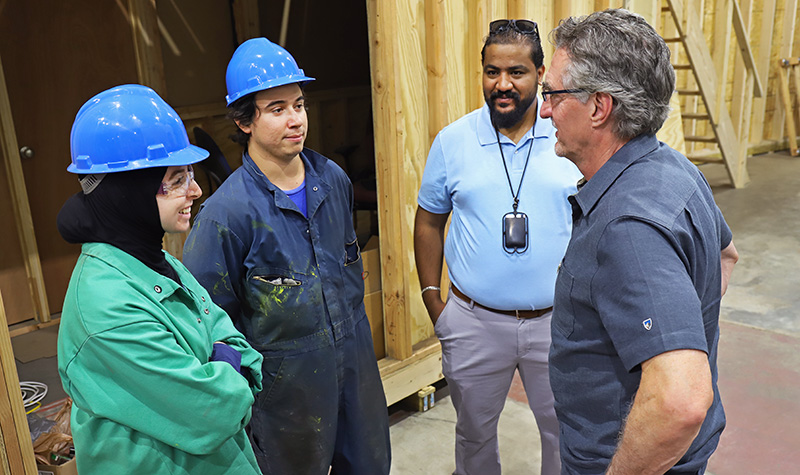
Gov. Burgum (right) visits with two UND petroleum engineering students. From the left are Mouna Benabid, Oscar Suarez and Foued Badrouchi, petroleum engineering assistant professor from Tunisia. Photo by Patrick C. Miller/UND Today.
